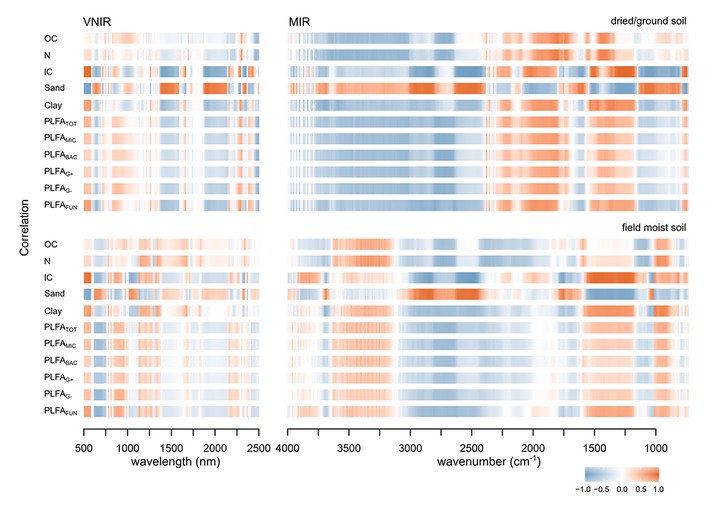VNIR and MIR Spectroscopy of PLFA-derived Soil Microbial Properties and Associated Soil Physicochemical Characteristics in an Experimental Plant Diversity Gradient

Abstract
Improving our understanding of the functions and processes of soil microbial communities and their interactions with the physicochemical soil environment requires large amounts of timely and cost-efficient soil data, which is difficult to obtain with routine laboratory-analytical methods. Soil spectroscopy with portable visible-to-near infrared (VNIR) and mid-infrared (MIR) instruments can fill this gap by facilitating the rapid acquisition of biotic and abiotic soil information. In this study, we evaluated the capabilities of VNIR and MIR spectroscopy to analyze soil physicochemical and microbial properties in a long-term grassland biodiversity-ecosystem functioning experiment. Soil samples were collected at the Jena Experiment (Jena, Germany) and measured with portable VNIR and MIR spectrometers in field-moist condition to determine their potential for on-site data collection and analysis. Reference data to calibrate spectroscopic models were acquired with routine analytical methods, including PLFA extractions of microbial biomarkers. We further collected reference VNIR and MIR data on pre-treated soils (dried and finely ground) to assess the anticipated impact of field measurements on spectroscopic calibrations. MIR spectra allowed more accurate estimates of soil physicochemical and microbial properties than VNIR data on pre-treated samples. For soils in field condition, MIR calibrations were more accurate for physicochemical properties, but VNIR data gave significantly better estimates of microbial properties. Combined VNIR/MIR estimates achieved the most accurate estimation results for all soil properties in each case. Soil physicochemical properties could be estimated from VNIR/MIR data with high accuracy (R2 = 0.72– 0.99) on pre-treated soil samples, whereas the results for soil microbial properties were more moderate (R2 = 0.66– 0.72). On field-moist soils, estimation accuracies decreased notably for organic and inorganic carbon ($Δ$RMSE = 52– 72%), improved slightly for soil texture ($Δ$RMSE = 4– 7%) and decreased slightly for microbial properties ($Δ$RMSE = 4– 9%). The VNIR/MIR estimates derived from soils in field condition were sufficiently accurate to detect experimental plant treatment effects on organic carbon, as well as bacterial and fungal biomass. We further found that spectroscopic estimates of soil microbial properties were primarily enabled through indirect correlations with spectrally active soil constituents, i.e., associations between soil microbial properties and the physicochemical soil environment. Our findings highlight the capacity of VNIR and MIR spectroscopy to analyze the physicochemical soil environment, including potential on-site data collection and analysis on soils in field condition, and indicate that VNIR/MIR data can estimate soil microbial properties when soil physicochemical properties shape the distribution of soil microbial communities.